 Gilman Studio On-Line Lessons
Gilman Studio On-Line Lessons
Yang Style Long Form
Tai Chi Chuan
This Lesson Contains:
The Six Harmonies
Movement # 28 – Stork Spreads Its Wings
The Six Harmonies
Tai Chi Chuan is such a marvelous practice. The more I study and learn, the more interesting it becomes, and the more I want to practice. A great cycle!
The Six Harmonies is a simple and instructive way to look at some of the self-defense principles of Tai Chi. The Harmonies is: foot and hand; knee and elbow; hip and shoulder. The Harmonies talk about how and when to use the particular tools of the Tai Chi practitioner. Let’s look and see if we can gain a deeper understanding of this topic.
Martial arts space is divided into three ranges: short or close, middle, and long or far. The martial practitioner must learn when and how to use the proper tool for the job. The leg is the longest limb of the body. At the end of the leg is the foot. It makes sense that kicks are used for offense or defense at the farthest range. The next longest limb is the arm. The hand is at the end of the arm. Punches and slaps are also used for long range. So for offense or defense at long range we have the first set of Harmonies – the feet and hands.
The knee and elbow are in the middle of arm and leg. These are the next set of Harmonies and are used for the middle distance. Finally we have the hip and shoulder, which connect the limb to the torso, and this set of Harmonies is used for close encounter.
All of this may seem very elementary, yet most Tai Chi practitioners tend to use the wrong tool for the job. Many people have no idea that the shoulder and hip are very powerful tools for the martial artist. They push with their hands when right next to their opponent. They kick when close. They lean when using shoulder, which indicates they are too far away. That is not to say one couldn’t use hands and feet in this way, yet it is not the optimum. One could break a board with a hammer, yet a saw is a better tool for that.
This movement, Stork Spreads Its Wings, clearly illustrates the use of the Harmonies. My opponent is at a distance when she attacks, so I use my hands to neutralize her. I then step in close since she is open and can attack me with her other hand, so I use shoulder to attack her. Finally, as she is moving away from the shoulder attack, I have more distance and attack with the elbow or forearm. I have used all the distance ranges and all my tools correctly.
Movement # 28 – Stork Spreads Its Wings
This is also a modified movement. This application is more traditional then the previous version, movement #9. In this movement we add a shoulder stroke before we spread our wings (arms).
The opponent attacks with her right arm. I neutralize it to the left, step inside and apply a shoulder strike, and end with a strike with the back of my right forearm.
There are some important points I want to make about this movement that illustrate principles connected to Tai Chi applications.
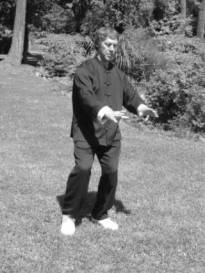
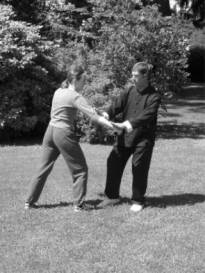 Anna attacks with her right fist and I join, stick, and neutralize to my left.
Anna attacks with her right fist and I join, stick, and neutralize to my left.
The weight shifts to the left foot and the right foot is pulled back into Ding Bow Toe. I can now use the forward foot to kick or block. As the body is drawn back, the waist turns slightly to the left.
The two arms follow the body back and to the left, and as they do, the palms turn to face forward. The arms drop to waist level. This is Lu Jing or roll back energy. Focus on palms.
Point #1. Try not to grab very often. Once you grab, you are committed to that action. For neutralizing, we most often use an open hand so we can stick and follow.
Point #2. Turn the side of the body to face the opponent. You expose less of yourself as a target and put one of your arms closer to the opponent.
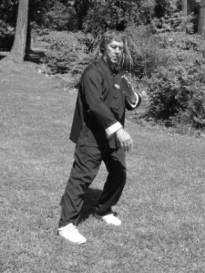
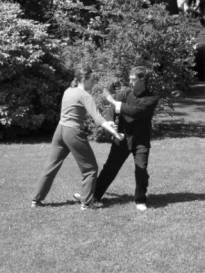 I step in and get ready to follow opponent’s retreating energy with a shoulder strike.
I step in and get ready to follow opponent’s retreating energy with a shoulder strike.
Lift up and replace the right foot in basically the same spot, but the toe will face half way between north and west. The body hasn’t moved, and do not put any weight on the foot yet.
As the foot is being replaced, the left hand comes up to the left side of chest and the right hand continues down to end up by the crotch. You are in center position.
Focus on the right palm for sticking.
Point #3. Do not remove your root from the weighted foot until you have established a new root with the other foot or you will be easily knocked off balance. This is not like normal walking. Watch people walk and notice they are always slightly out of balance.
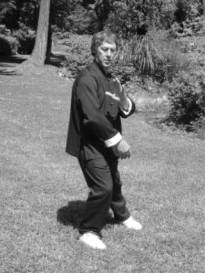
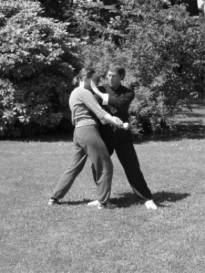 I apply shoulder stroke (Kao Jing).
I apply shoulder stroke (Kao Jing).
Shift the weight onto the right foot. Be careful not to lean or over extend. Keep the knee in line with the toe. It is easy for the knee to collapse inward.
The arms stay in the same basic relationship. The right hand anchors the opponent, and the left hand is ready to block or strike.
Focus on the right shoulder.
Point #4. When applying force to a body, you have several choices of how you want the force to act upon the body. I could bounce Anna away, upset her balance and make her fall, or send energy into her body to cause pain. In this instance, I am holding on to her arm so that the energy could penetrate instead of bouncing her away.
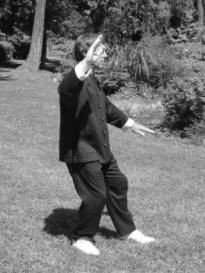
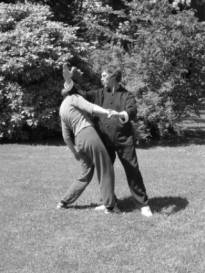 I follow the shoulder strike with an elbow or forearm strike.
I follow the shoulder strike with an elbow or forearm strike.
The torso turns to the left to face west. The left foot is replaced to the front into Ding Bow Toe. Do not stand up.
The stork spreads wings. The two arms separate with the right flowing upward to end on the right side of the body. The right elbow is drooped, with the palm about face level facing the front. Don’t let the right arm get behind the body. The left hand has moved to the left side of the waist with the palm facing downward.
Focus on the right forearm and the left palm.
Point #5. Energy must be balanced internally. The strong upward and backward force of the right arm is balanced by the downward and outward energy of the left palm. Always seek this balance.
